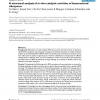Free Online Productivity Tools
i2Speak
i2Symbol
i2OCR
iTex2Img
iWeb2Print
iWeb2Shot
i2Type
iPdf2Split
iPdf2Merge
i2Bopomofo
i2Arabic
i2Style
i2Image
i2PDF
iLatex2Rtf
Sci2ools
BMCBI
2007
2007
A structural analysis of in vitro catalytic activities of hammerhead ribozymes
Background: Ribozymes are small catalytic RNAs that possess the dual functions of sequencespecific RNA recognition and site-specific cleavage. Trans-cleaving ribozymes can inhibit translation of genes at the messenger RNA (mRNA) level in both eukaryotic and prokaryotic systems and are thus useful tools for studies of gene function. However, identification of target sites for efficient cleavage poses a challenge. Here, we have considered a number of structural and thermodynamic parameters that can affect the efficiency of target cleavage, in an attempt to identify rules for the selection of functional ribozymes. Results: We employed the Sfold program for RNA secondary structure prediction, to account for the likely population of target structures that co-exist in dynamic equilibrium for a specific mRNA molecule. We designed and prepared 15 hammerhead ribozymes to target GUC cleavage sites in the mRNA of the breast cancer resistance protein (BCRP). These ribozymes were tested, and their...
| Added | 12 Dec 2010 |
| Updated | 12 Dec 2010 |
| Type | Journal |
| Year | 2007 |
| Where | BMCBI |
| Authors | Yu Shao, Susan Wu, Chi Yu Chan, Jessie R. Klapper, Erasmus Schneider, Ye Ding |
Comments (0)

